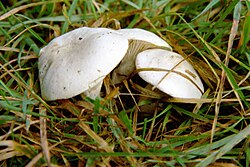| Clitopilus | |
|---|---|
 | |
| Clitopilus prunulus | |
| Scientific classification | |
| Kingdom: | Fungi |
| Division: | Basidiomycota |
| Class: | Agaricomycetes |
| Order: | Agaricales |
| Family: | Entolomataceae |
| Genus: | Clitopilus (Fr. ex Rabenh.) P.Kumm. (1871) |
| Type species | |
| Clitopilus prunulus | |
| Synonyms [1] | |
Clitopilus is a genus of fungi in the family Entolomataceae. The genus has a widespread distribution, especially in northern temperate areas. Although a 2008 estimate suggested about 30 species in the genus, [2] a more recent publication (2009) using molecular phylogenetics has redefined the genus to include many former Rhodocybe species. [3]